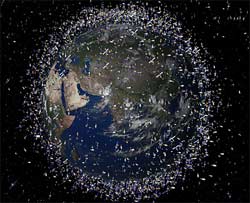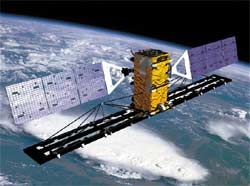Space junk: Clear and present danger
23 Mar 2009
Ottawa: Soon after a spate of alerts and scares faced by NASA space missions from free floating junk in space comes the news that two Canadian satellites are passing through massive clouds of junk caused by a recent collision between a Russian and an American satellite. Scientists say both the satellites may now be in danger of being damaged or destroyed.
The news comes hard on the heels of news from NASA on Sunday that it had ordered space
 |
| A European Space Agency computer generated image depicts 11,500 pieces of space junk in low Earth orbit. |
The two Canadian satellites, RADARSAT-1 and RADARSAT-2 - which cost Ottawa almost $1 billion to build - orbit the Earth 14 times each day travelling east to west. Clusters of space junk from the American-Russian satellite collision are travelling north to south and scientists believe they could be on a collision course.
''There is a very high risk for the two satellites,'' said Robert Saint-Jean, manager of satellites at the Canadian Space Agency.
The RADARSATS collect data used in monitoring ocean, land and ice development.
Meanwhile, NASA's Sunday scare came from a small piece of junk originating from a 10-year-old Chinese satellite rocket motor, which would have come uncomfortably close during Monday's planned spacewalk. The size of the junk projectile - all of four inches!
To avoid an unintended encounter, Discovery's pilots fired their ship's thrusters to reorient the shuttle and the ISS and so avoided the Chinese space projectile.
Earlier this month, the three space station astronauts were forced to take shelter in their emergency getaway capsule when another piece of space debris threatened to come too close.
Last week, even as Discovery was due to arrive, the space station would have been forced to dodge yet another piece of junk – this time from a derelict Soviet satellite. This piece, however, maintained a safe distance.
 Nasa scientists say that space debris has indeed become an ever-increasing challenge and dodging junk a very tiresome game that has to be played out.
Nasa scientists say that space debris has indeed become an ever-increasing challenge and dodging junk a very tiresome game that has to be played out.
In the recent 10 February crash of the American Iridium 33 and the Russian Cosmos 2551 satellites more than 500 large pieces of debris, some larger than a tennis ball, as well as millions of smaller pieces, were created. These smaller pieces cannot be tracked.
According to Nasa sources, pieces of the destroyed satellites are scattered as low as 500 kilometres and as high as 2,000 kilometres above the Earth's surface.
It is well known that the speed at which things travel in space, even a small fleck of paint can blast a hole through a windshield.
Current technology can only monitor space debris larger than 10 centimetres in diameter, Nasa scientists say, so anything smaller than that are really the most dangerous.
Space debris is currently tracked by Stratcom, a branch of the US Air Force.
Scientists say that there really is very little that can be done about space debris, other than to hope that in 50-100 years time they will re-enter the atmosphere and burn out.
It is estimated there are at least 11,500 pieces of space junk in low Earth orbit and at least 1,147 pieces in geostationary orbit. With more than 600 satellites in orbit, the amount of space junk is increasing by at least 200 per year.













.jpg)






.jpg)









